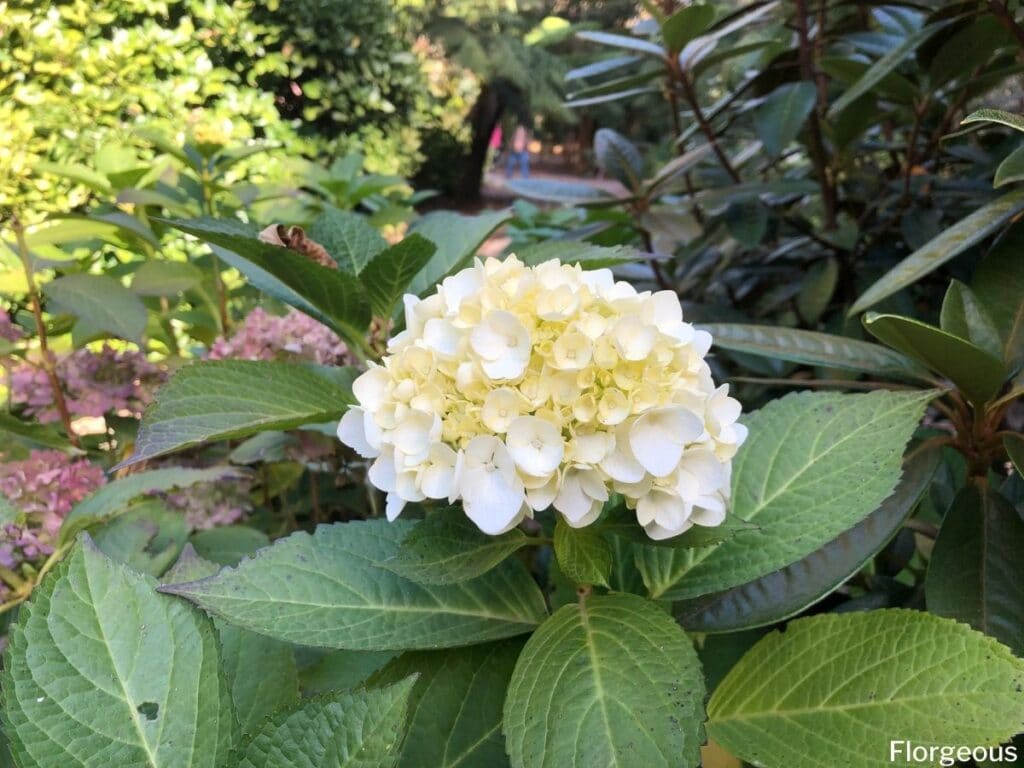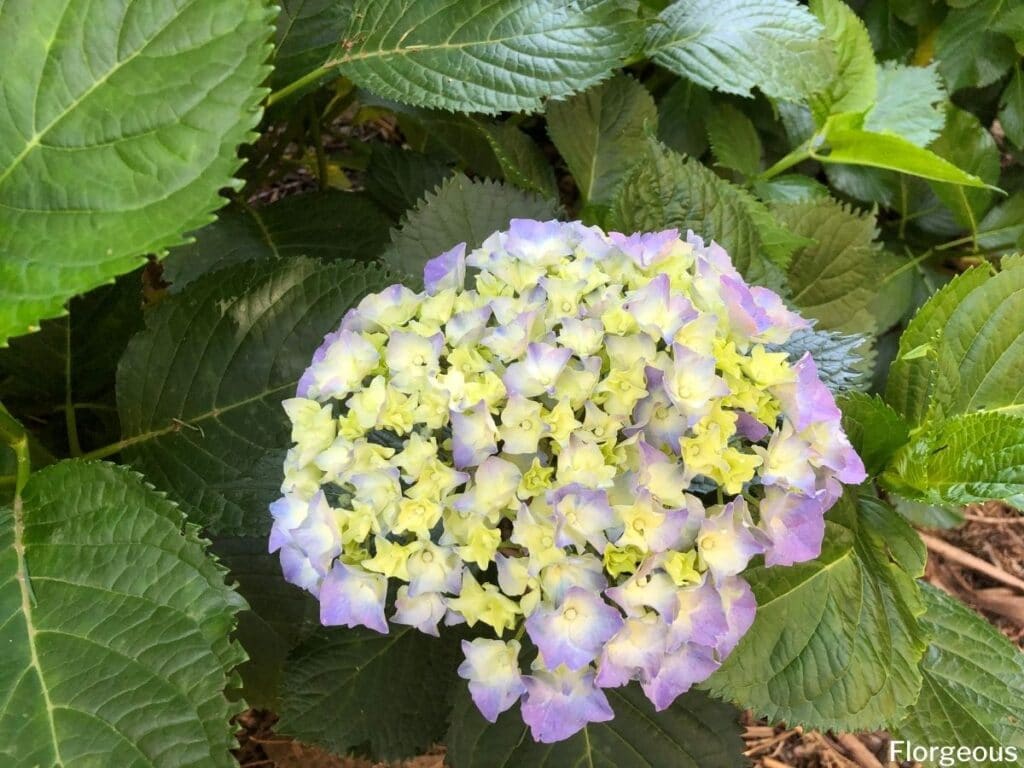There are many flowering plants in the world (nearly 400,000 individual species in fact) and among them, many are instantly recognizable even to the non-horticulturist. Roses, lilies, and daisies all have distinctive characteristics that draw immediate attention and make them stand out. Another flower that many people have come to love and appreciate is the Hydrangea.
There are almost 75 species in this family of flowering shrubs and one of the most common varieties is the bigleaf hydrangea bush (French hydrangea).
Here’s how to grow these beautiful blooms for yourself.
What is Bigleaf Hydrangea?
This is a common name for the species Hydrangea Macrophylla. Both the family and species names come from Greek. Hydrangea name stems from “hydros” for water, and “angos” for jar, due to the shape of its leaves resembling a pitcher. The species name “macros” means large or long and “phylo” is leaf. Other common names include French Hydrangea and Hortensia.
The species originated in Japan and was introduced to Europe only in 1736 when a colonist brought back an example from North America, where it also grows naturally. This hardy plant produces flowers from early summer to early winter but is deciduous, meaning it drops its flowers once the plant has reached full maturity.
It is a shrub, so the woody trunk can withstand colder temperatures and less sunlight than herbaceous plants.
The defining characteristic of the Hydrangea macrophylla is the orb-shaped flower clusters. New shoots stem from the trunk in the spring and so begin blossoming into colorful flowers around the end of the shoot.
The flowers themselves are very small dots in the center of larger sepals (these look like flower petals but surround the actual flower). The color of Hydrangea macrophylla is dependent largely on the soil acidity, and ranges from white to purple, with nearly every color on the spectrum in between. The most common colors are between blue and violet, with mixed varietal colors occurring naturally as well.

Commonly-Grown Types of Hydrangea Macrophylla
Hydrangea Macrophylla is an incredibly popular species for captive cultivation, as both cut flowers for bouquets as well as for gardening and landscaping design.
There are two cultivars that are considered the most common: Mophead and Lacecap.
Mophead Hydrangea
Mophead hydrangea is the most popular and easily the most recognizable hydrangea. Also known as ‘Endless Summer,’ the flowerheads are perfect orbs of tightly packed flowers and sepals that resemble the head of a mop, and most commonly come in a periwinkle blue hue. These plants require high amounts of water but also soil that drains well. In landscaping, they are known to be resistant to fire.
These grow well in shade and are typically low-maintenance plants that produce very colorful and numerous flowers. The “mopheads” themselves are as big as 6-8 inches across.
Lacecap Hydrangea
Lacecap hydrangeas have a delicate appearance with large sepals rising from the more numerous, fertile flower buds. The sepals themselves look similar to Mopheads though fewer in number, and grow in a ring around the buds in the center; the flower cluster appears flatter, rather than in a sphere.
The care for this plant is identical to Mopheads as well, flowering in shade and requiring much soil moisture and drainage. This cultivar is hardy, and you can easily rejuvenate old buds with pruning.
Growing Bigleaf Hydrangea Bush
Bigleaf hydrangea bushes can be grown in a variety of landscapes and climates with little care and attention. Avoid full sun and be sure to give ample shade, as these species thrive in indirect sunlight as well.
The woody stems are tough and generally resistant to disease and pests, though can still be afflicted if they are neglected.
As long as they are given plenty of water, fertilizer in early spring when needed, and lively soil that drains well, these hydrangeas will return year after year and give you many successful flowering seasons.
Let’s get into some specifics about how to cultivate this beautiful plant.
How To Plant Bigleaf Hydrangea
Planting your Hydrangea macrophylla should be relatively easy, as this species does well in a variety of environments as long as it gets enough water.
For this reason, you will want to avoid planting in dry, exposed, shadeless sites; near other taller plants or trees is best, as they are actually known to prosper in shade.
The plant will flourish given plenty of room to grow; for example, if you desire a large plant, give it ten square feet with organic compost distributed into the top eight to twelve inches of topsoil.
They can also be grown well in containers, with an added advantage being portability. Obviously, these plants will become stunted and remain smaller than ground plants. When planting, make sure the root ball is level with the soil surface to ensure proper drainage.
If you are using hydrangea seeds or seedlings, check our guide to learn when to plant hydrangea seeds.

Caring For Bigleaf Hydrangea
Here are some tips when it comes to caring for hydrangeas.
Watering
Hydrangeas require lots of water to keep them happy. If you live in an area that receives rainfall, monitor the soil moisture and water when the plants begin to wilt. Always check that your soil drains well and adjust it accordingly. You shouldn’t have to water more than once a week, making sure to get a soak down two inches or so.
For drier or sunnier climates, watering in the early morning or at night will help your plant retain water during the heat of the day and avoid scorching in the sun.
Mulching the topsoil will help in arid areas, but beware of overwatering. The mulch can trap a lot of moisture and you will want to avoid root disease. In the spring, be very wary of stressing your plant as they are sensitive during the bloom.
Basically, your plant will do well on its own as long as the top inch or so of soil is moist.
Weeding
Weeds growing around your plants can wreak havoc on them. You want to pay particular attention to unwanted plants in your garden in any case, and while hydrangeas are hardy plants, they can be choked out like any other garden variety. Because they require so much moisture, weeds will often attempt to move into the growing area, sapping vital water from reaching your hydrangea.
There are even plants that can cross-pollinate and become almost hybrid plants that can trick you into thinking you’ve sprouted new shrubs! Weeds will also promote insects and disease by giving them a foothold and easy food source under your plant. Beware weed-killers as they can damage your plant as well, and negatively affect the soil acidity, creating further problems for the hydrangea.
Companion planting is one effective way to minimize the growth of weeds. Check our list of what to plant in front of hydrangeas to get more ideas.
Fertilizing
Organic and composted options should be your first choice. If those are not viable options, a common all-purpose 10-10-10 or 12-4-8 fertilizer compound can work wonders.
Typically, you should only have to fertilize once a year during the growing season (spring time) but you can bolster your plant by fertilizing in late summer if it needs a boost. Twice a year, liquid iron may be incorporated into the soil to keep your leaves a healthy green.
Pests and Diseases
Hydrangea bushes are particularly susceptible to aphids, black vine weevil, four-lined plant bugs, Japanese beetles, and more.
Your flowers will not perform well with recurring insecticide use, so catching the pests as early as possible is the key to stopping infestations before they begin. The most effective solution is to individually inspect your plants often, give a good spray down with water or diluted, mild insecticidal soap.
These plants are fairly resistant to disease but some common issues include powdery mildew, root rot, botrytis blight, and a variety of other fungi. Mildew and fungus problems are usually only cosmetic, but root rot and various forms of blight (causes leaves to deteriorate) are more serious and require immediate treatment. In addition, hydrangea leaf problems can also occur.
For mildew/fungus, spores will collect in plant debris and fallen leaves, removing these and pruning afflicted parts of the plant should suffice. As far as root rot goes, maintaining the best growing conditions as possible is the best defense.
High-stress environments render these plants especially vulnerable to root rot, such as drought, overwatering, or pH-unbalanced soil. There is no chemical control, and once taken hold, root rot is very difficult to recover from, so always monitor your plant’s health as closely as possible.
Conclusion
There are many hydrangea types and your flowers can be altered to your liking year to year by changing the growing environment. Happy planting and good luck!
Learn more about hydrangea flower meaning to see why people love this plant!






